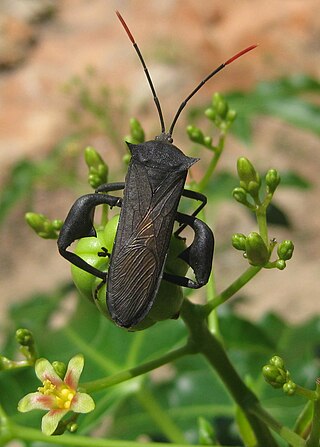
Coreidae is a large family of predominantly sap-sucking insects in the Hemipteran suborder Heteroptera. The name "Coreidae" derives from the genus Coreus, which derives from the Ancient Greek κόρις (kóris) meaning bedbug.

Euphorbia corollata is an herbaceous perennial plant in the family Euphorbiaceae that is native to North America. A common name for the species is flowering spurge. It has a milky sap that can cause skin and eye irritation in some people. It grows up to 1 m (3 ft) tall, with smooth stems and light green leaves arranged alternately or in whorls. Leaves are about 10 mm wide and 75 mm (3 in) long. Each stem terminates in a panicle 20 to 25 mm across. Flowers are about 6 mm across and consist of one pistillate and several staminate flowers surrounded by five white bracts - not petals but formed from the involucre at the base of the flowers. Flowering spurge blooms from June to September.
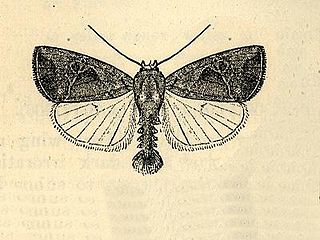
Elaphria nucicolora, the sugarcane midget, is a moth of the family Noctuidae. The species was first described by Achille Guenée in 1852. It is found from the south-eastern United States, through Guadeloupe, Jamaica and Puerto Rico to tropical South America. It is also present on the Hawaiian islands of Oahu, Maui and Hawaii.
BugGuide is a website and online community of naturalists, both amateur and professional, who share observations of arthropods such as insects, spiders, and other related creatures. The website consists of informational guide pages and many thousands of photographs of arthropods from the United States and Canada which are used for identification and research. The non-commercial site is hosted by the Iowa State University Department of Entomology. BugGuide was conceived by photographer Troy Bartlett in 2003 and since 2006 has been maintained by John VanDyk, an adjunct assistant professor of entomology and a senior systems analyst at Iowa State University. The website has been recognized for helping change public perception of insects.
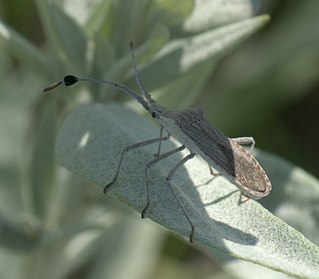
Chariesterini is a tribe of leaf-footed bugs in the family Coreidae. There are at least 4 genera and more than 20 described species in Chariesterini.

Chimarra is a genus of little black caddisflies in the family Philopotamidae. There are more than 630 described species in Chimarra.
Lopidea major, the Red Mountain laurel mirid, is a species of plant bug in the family Miridae. It is found in Central America and North America. It is a frequently-encountered pest of the Texas Mountain Laurel, though they apparently do little real damage.

Cerastipsocus venosus is a species of common barklouse in the family Psocidae. It is found in the Caribbean Sea, Central America, and North America. Nymphs often move in a tightly packed herd. They feed on lichen.
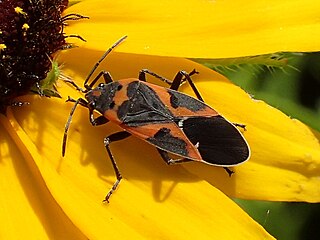
Lygaeus kalmii, known as the small milkweed bug or common milkweed bug, is a species of seed bug in the family Lygaeidae. It is found in Central and North America.
Hemileuca grotei, or Grote's buck moth, is a species of insect in the family Saturniidae. It is found in North America.
Prepops fraternus is a species of plant bug in the family Miridae. It is found in North America. It is normally found on sumac.
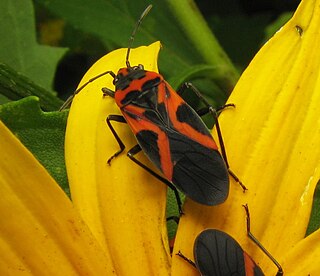
Lygaeus turcicus, the false milkweed bug, is a species of seed bug in the family Lygaeidae. It is found in Eastern North America.

Chrysopa oculata is a species of green lacewing in the family Chrysopidae. It is found in North America and Central America. This species was imported to New Zealand in 1926, as a way to control aphid populations, however did not establish in the country.
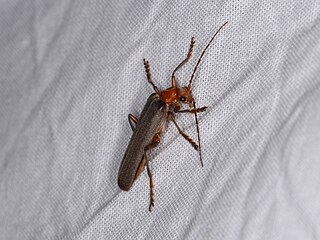
Pacificanthia consors is a species of soldier beetle in the family Cantharidae. It is found in North America, mainly in California. Adults are 14-19 mm in length. They are orange with brown wing covers, and the legs are reddish with black markings.
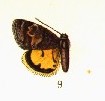
Annaphila depicta, also called the rusty-barred annaphila, is a species of moth in the family Noctuidae. It is found in North America. The wingspan is 21-24 mm. Its forewing is gray with a reddish-brown band. The hindwing is orange with black markings. It looks similar to Annaphila decia, but A. decia has more black markings on its hindwings than A. depicta. A. depicta's larvae are green and feed on Nemophila menziesii.

Diabrotica cristata, the black diabrotica, is a species of skeletonizing leaf beetle in the family Chrysomelidae. It is found in North America.
Desmona is a genus of northern caddisflies in the family Limnephilidae. There are at least two described species in Desmona.
Pterostichus adoxus is a species of woodland ground beetle in the family Carabidae. It is found in North America. Larvae are predators.

Rhionaeschna californica, the California darner, is a species of darner in the dragonfly family Aeshnidae. It is found in Central America and North America. And prefers habitats like lakes, ponds, marshes and stream pools with edge vegetation including many with alkaline water conditions Larvae sustain themsevles on a diet of aquatic insects,very small fish and tadpoles. The adult-stage will eat almost any soft-bodied flying insect.
Hemileuca griffini, known generally as the Griffin's sheepmoth or Canadian fleabane moth, is a species of insect in the family Saturniidae. It is found in North America.













